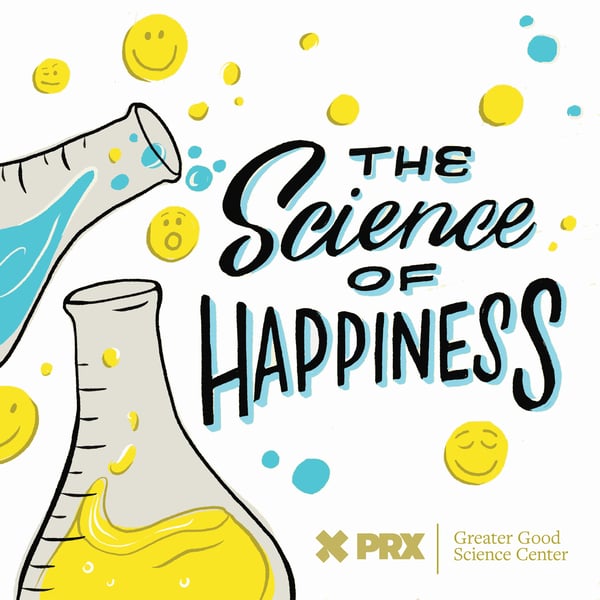Making Music With Your Body, With Keith Terry | Happiness Break
The Science of Happiness
PRX and Greater Good Science Center
4.4 • 1.9K Ratings
🗓️ 6 March 2025
⏱️ 8 minutes
🧾️ Download transcript
Summary
How to Do This Practice:
- Find a Comfortable Space: Choose a place where you feel comfortable moving and making noise. You can do this practice standing or seated, whatever feels best for you.
- Start with a Basic Clap: Clap your hands together lightly, palm to palm. Keep the pressure soft so it doesn’t hurt. Try a few claps, following a steady rhythm.
- Add Chest Percussion: After each clap, tap your sternum lightly with your right hand, then with your left hand. Repeat this rhythm several times.
- Incorporate Leg Taps: Extend the pattern by adding taps on your thighs.
- Repeat the Full Pattern: Put it all together in a continuous loop— clap, chest (right, left), legs (right, left). Maintain the rhythm and repeat without pauses.
- Focus on the sensation of movement and sound as a mindful practice.
Scroll down for a transcription of this episode.
Today’s Happiness Break host:
KEITH TERRY is a percussionist and body musician who uses a variety of surfaces to create interesting rhythms.
Learn more about Keith Terry: https://tinyurl.com/5av66v5f
Watch Keith Terry in action: https://tinyurl.com/299vuw4a
Related Happiness Break episodes:
A Humming Technique to Calm Your Nerves: https://tinyurl.com/mr42rzad
The Healing Power of Your Own Touch: https://tinyurl.com/y4ze59h8
How to Relax Your Body Through a Standing Meditation: https://tinyurl.com/2fv4c9h8
Related Science of Happiness episodes:
Why Dancing Is The Best Medicine: https://tinyurl.com/y66hxxy9
The Science of Humming: https://tinyurl.com/4esyy6nd
How Music Can Bridge Cultures: https://tinyurl.com/5ar3c8yy
Follow us on Instagram: @ScienceOfHappinessPod
We’d love to hear about your experience with this practice! Share your thoughts at [email protected] or use the hashtag #happinesspod.
Find us on Apple Podcasts: https://tinyurl.com/2p9h5aap
Help us share Happiness Break! Leave a 5-star review and share this link: https://tinyurl.com/2p9h5aap
Transcription: https://tinyurl.com/275tna6h
Transcript
Click on a timestamp to play from that location
| 0:00.0 | I'm Dr. Keltner. Welcome to Happiness Break, where we take a short break in the day to try a practice |
| 0:08.0 | shown to help us find a sense of calm and connection with ourselves and each other. |
| 0:13.0 | Today we're going to do something kind of different. |
| 0:15.0 | We're going to create rhythms using nothing but our bodies in a kind of musical meditation. |
| 0:24.6 | Body percussion practices have been shown to help reduce stress and anxiety, |
| 0:27.4 | boost self-esteem, and help us focus. |
| 0:30.5 | And when we move our bodies in sync with other people, |
| 0:34.1 | this helps us feel more compassion, behave more altruistically, |
| 0:36.3 | thanks to higher levels of oxytocin. |
| 0:42.9 | Leading us today is Keith Terry, a world-renowned composer and percussionist who uses his own body as his instrument. |
| 0:45.2 | We're going to follow along as Keith guides us through a practice he created called body |
| 0:50.8 | music, starting with just some basic claps and moving right along into some rhythms |
| 0:56.2 | using the chest. So find somewhere where you feel comfortable, where you can move around a little, |
| 1:02.1 | and where it's okay for you to get into your body and make some noise. Here's Keith. |
| 1:10.4 | Hi, I'm Keith Terry. |
| 1:11.6 | I'm a musician. |
| 1:12.6 | I'm a rhythm dancer and I'm an educator. |
| 1:16.6 | And in the 1970s, as a result of working with a lot of tap dancers, |
| 1:21.6 | I had the thought that I could stand up and I could play all the rhythms I was playing on my drums on my body. |
| 1:28.3 | They were really inspiring to me and I became a body musician. |
| 1:35.3 | Body music is fun and useful in artistic ways in music and dance, choreography, |
| 1:41.3 | but it also has therapeutic values I've discovered over the years. |
... |
Please login to see the full transcript.
Disclaimer: The podcast and artwork embedded on this page are from PRX and Greater Good Science Center, and are the property of its owner and not affiliated with or endorsed by Tapesearch.
Generated transcripts are the property of PRX and Greater Good Science Center and are distributed freely under the Fair Use doctrine. Transcripts generated by Tapesearch are not guaranteed to be accurate.
Copyright © Tapesearch 2025.

